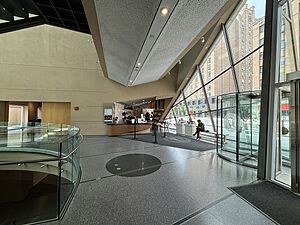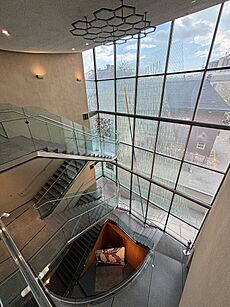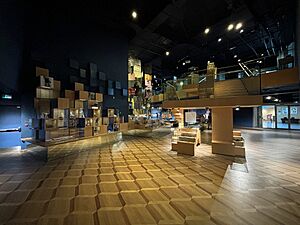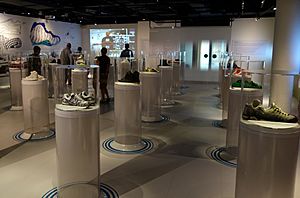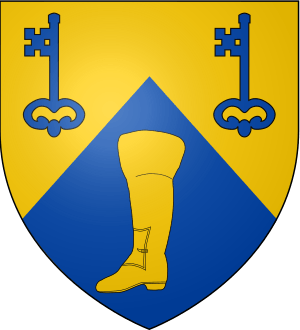Bata Shoe Museum facts for kids

The museum building on Bloor Street in 2023
|
|
| Lua error in Module:Location_map at line 420: attempt to index field 'wikibase' (a nil value). | |
| Established | 1979 |
|---|---|
| Location | 327 Bloor Street West Toronto, Ontario, Canada |
| Type | Calceology |
| Visitors | 110,334 (2018) |
| Founder | Sonja Bata |
| Architect | Moriyama & Teshima Architects |
| Public transit access | |
The Bata Shoe Museum (often called BSM) is a special museum in Toronto, Canada. It's all about shoes and the study of footwear, called calceology. You can find the museum in downtown Toronto, close to the University of Toronto. The building is about 3,665 square meters (39,450 square feet) and was designed by Moriyama & Teshima Architects. Raymond Moriyama was the main architect.
The museum's amazing collection of shoes started with Sonja Bata. She began collecting shoes in the mid-1940s. In 1979, Sonja Bata created the Bata Shoe Museum Foundation. Her goal was to have her collection looked after by experts and to build a museum to keep and show the shoes. The foundation first showed parts of the collection in 1992. The museum's permanent home officially opened in May 1995.
As of 2018, the museum has over 13,000 shoes and other items related to footwear. Some items are as old as 4,500 years! This makes it the largest collection of footwear in the world. Many items are stored safely, while others are on display in the main exhibition. The museum also has special temporary shows and programs for visitors.
Contents
The Museum's Story
The museum's collection began with Sonja Bata's personal interest in shoes. She started collecting them after marrying Thomas J. Bata in 1946. Her husband's family owned the famous Bata shoe company. The Bata family moved to Toronto in the 1940s to help the company grow in North America. In 1965, the company's main office moved from Zlín to Toronto.
By the late 1970s, Sonja's collection had grown to 1,500 pairs of shoes! They were taking up too much space in the company's storage rooms. A friend suggested that Sonja create a foundation to manage the collection. So, in 1979, she started the Bata Shoe Museum Foundation. This group would fund research about shoes and take care of the collection. Even though it shared the Bata name, the foundation was a separate, non-profit group. Sonja Bata wanted the museum to be funded privately, not by public money. The museum is mainly supported by a special fund created by the Bata family's own money.
After the foundation was set up, they looked for a building to keep the shoes, display them, and have research areas. There were ideas to build the museum near the Ontario Science Centre or in the Harbourfront area of Toronto, but these plans didn't work out. Sonja Bata wanted to build at Harbourfront, but there were public protests. The city council even suggested removing "Bata" from the museum's name, but Sonja refused. So, the Harbourfront plan was dropped.
The collection was first shown to the public in Toronto in 1992 at a shopping complex. The foundation then hired Moriyama & Teshima Architects to design a special museum building. This building opened its doors on May 6, 1995. The exact cost of building it was not shared, but estimates were between C$8 million and C$12 million.
In January 2006, some very valuable items were stolen from the museum. These included jewel-covered Indian slippers that belonged to Sikandar Jah, a gold anklet, and a toe ring. The slippers alone were worth about C$160,000 at the time. Luckily, the stolen items were found and returned to the museum a few weeks later.
The Museum Building
The museum is in a 3,665 square meter (39,450 square foot) building. It's on the corner of St. George Street and Bloor Street West. This is close to the University of Toronto's St. George campus. Before the museum was built, there was a gas station on this spot. The closest subway station is St. George station.
The building has three floors and was designed by Moriyama & Teshima Architects. Raymond Moriyama was the lead architect. He got the idea for the building's shape from the special boxes used to store the Bata family's shoe collection. The building looks like a shoe box with its lid tilted slightly open. This style is called Deconstructivism.
The building uses almost all the land it's on because of local rules about how tall buildings can be. The outside of the building is made of smooth, angled limestone from France. There are also glass walls that stick out, forming the entrance. Some windows are high up, about 12.8 meters (42 feet) above the ground.
Inside, the museum has three main sections spread across five floors. Besides the exhibit rooms, there's also a gift shop, a lecture hall, and a reception area. The floors on the lower levels are made of dark wood in a diamond pattern. This design makes you look down at your own feet! The main hall has a central staircase decorated with bronze medallions made by Dora de Pedery-Hunt. Circles are cut into the stair steps to let in light from the windows above. The staircase goes down two floors below ground. A tall stained glass panel, about 12.8 meters (42 feet) high, is next to the main stairs. Even the reception desk, covered in leather, is designed to look like a shoe when seen from the staircase.
Museum Exhibitions
The museum has four galleries for showing shoes. One gallery holds the permanent exhibition, and the other three are for temporary shows. The permanent exhibition is called All About Shoes: Footwear Through the Ages. It's located on the two lower levels on the east side of the building. The temporary exhibitions are on the second and third floors.
The galleries are designed to be "neutral spaces." This means they can easily be changed to fit different types of exhibits. To protect the delicate shoes, the galleries have special controls for temperature and humidity. Also, very little natural light enters these rooms.
Besides the shows in the building, the museum also has online exhibitions. You can even find an online version of the All About Shoes permanent exhibition. The Virtual Museum of Canada has also hosted online exhibits created by the Bata Shoe Museum.
All About Shoes: The Permanent Exhibition
The museum's main exhibition, All About Shoes, takes you on a journey through the history of footwear. It has interactive displays that show how important shoes have been in different cultures. You can also learn about how shoes have been made over time. There are small models of shoe-making workshops from different periods, with videos and text to explain them.
This exhibition has three parts: Behind the Scenes: A Glimpse into Artifact Storage, Fashion Afoot, and What's Their Line?.
- Fashion Afoot looks at how fashion shoes developed in the 20th century. It shows how shoes became a major fashion item.
- What's Their Line? features special shoes made for specific purposes. This includes French clogs used for crushing chestnuts and sumo wrestler's geta (wooden sandals).
- The Behind the Scenes part shows shoes and other items from the museum's collection that are usually kept in storage.
The exhibits were designed so that the shoes are close to you. Black and white images of daily life are shown to help you understand how the shoes were used long ago. Larger pictures behind the exhibits help show where the shoes came from. The lighting in the exhibition is dim to protect the old shoes from damage. Shoes are usually displayed on low platforms made of light-colored maple wood.
The smallest shoes you might see in the permanent exhibition are tiny 7.6-centimeter (3-inch) Chinese shoes. These were made for women who had their feet bound. The exhibition also has a plaster copy of the oldest known human-like footprint. It's from Laetoli, Tanzania, and is 3.7 million years old!
Temporary Exhibitions
The museum often hosts special temporary exhibitions in its other galleries. The first three temporary shows opened in May 1995. These included The Gentle Step, about how women's shoes changed in the 19th century. One, Two, Buckle My Shoe focused on shoes in children's books. Inuit Boots: A Woman's Art showed how Inuit mukluks are made.
Here are some examples of temporary exhibitions held at the museum:
- Inuit Boots: A Women's Art (1995–1996)
- One, Two, Buckle My Shoe: Illustrations from Contemporary Children's Books about Shoes (1995–1996)
- The Gentle Step – The Ladies Realm of Fashion 1800–1900 (1995–1997)
- Shoe Dreams: Designs by Andrea Pfister (1996–1997)
- Tradition and Innovation: Northern Athapaskan Footwear (1996–1997)
- Dance! – Minuet to Disco (1997–1999)
- Loose Tongues and Lost Soles: Shoes in Cartoon and Caricature (1997)
- Footwear Fantasia: Shoe Sculptures by Garry Greenwood (1997)
- The Taming of the Shoe: From Attic to Exhibition (1997–1998)
- Spirit of Siberia (1997–1998)
- Little Feats: A Celebration of Children's Shoes (1998–1999)
- Footsteps on the Sacred Earth: Southwestern Native Footwear (1998–1999)
- Japanese Footgear: Walking the Path of Innovation (1999–2000)
- Herbert and Beth Levine: An American Pair (1999–1999)
- Paduka: Feet and Footwear in the Indian Tradition (1999–2000)
- Every Step a Lotus: Shoes in the Lives of Chinese Women from Late Imperial China (2001)
- Heights of Fashion: A History of the Elevated Foot (2001)
- The Perfect Pair: Wedding Shoe Stories (2002–2004)
- Paths Across the Plains: Native Footwear of the Great Plains (2004–2005)
- Icons of Elegance: Influential Shoe Designers of the 20th century (2005–2007)
- Watched by Heaven, Tied to Earth: Summoning Animal Protection for Chinese Children (2006–2007)
- The Charm of Rococo: Femininity and Footwear of the 18th century (2006–2008)
- On Pointe: The Rise of the Ballet Shoe (2008–2009)
- Beauty, Identity, Pride: Native North American Footwear (2009)
- On a Pedestal: From Renaissance Chopines to Baroque Heels (2009–2010)
- Socks: Between You and Your Shoes (2010)
- Art in Shoes/Shoes in Art (2010)
- The Roaring 20's: Hemlines, Heels and High Hopes (2011)
- Roger Vivier: Process to Perfection (2012)
- Collected in the Field: Shoemaking Traditions from Around the World (2013)
- Out of the Box: The Rise of Sneaker Culture (2013)
- Fashion Victims: The Pleasures and Perils of 19th Century Dress (2014)
- Standing Tall: The Curious History of Men in Heels (2015)
- Manolo Blahnik: The Art of Shoes (2018)
- WANT: Desire, Design and Depression Era Footwear (2018)
- The Gold Standard: Glittering Footwear From Around the Globe (2021)
- Art & Innovation: Traditional Arctic Footwear from the Bata Shoe Museum Collection (2021)
- All Dolled Up: Fashioning Cultural Expectations (2022)
- The Great Divide: Footwear in the Age of Enlightenment (2022)
- Future Now: Virtual Sneakers to Cutting-Edge Kicks (2023)
- Obsessed: How Shoes Became Objects of Desire (2023)
- In Bloom: Flowers & Footwear (2023)
- Dressed to Impress: Footwear and Consumerism in the 1980s (Now on view until March 2025)
- Exhibit A: Investigating Crime and Footwear (Now on view until September 2025)
- Art/Wear: Sneakers x Artists (Now on view until March 2026)
The Permanent Collection
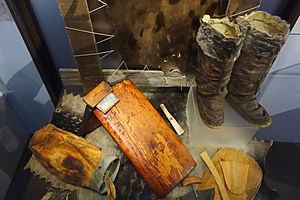
As of April 2018, the museum's permanent collection has over 13,000 shoes and related items. Some pieces date back 4,500 years! This makes it the world's largest and most complete collection of items focused only on footwear.
The collection was first meant to be a "working collection" for the Bata family. They wanted to learn shoe-making techniques from different cultures. Later, the goal changed to be a historical and anthropological collection. Sonja Bata started collecting shoes from local people in places where Bata factories were replacing traditional footwear. She wanted to save and record these older shoe styles. Today, the museum gets new items by buying them at auctions, receiving donations, doing field research, or from private sellers. The museum's goal is to preserve shoes, not to fully restore them. This means they stop shoes from getting worse, but they don't remove signs of wear or replace missing parts. This is part of the museum's belief that worn shoes have important cultural meaning.
The collection is organized by different cultures and regions. These include Africa, China, India, Japan, Korea, Latin America, the Middle East, and indigenous North America. Shoes from First Nations and northern Canada make up a big part of the museum's collection. About four percent of the museum's collection is on display. The rest is kept safe in storage. Stored items are placed in two special underground vaults. The museum also shows some "stored items" in clear boxes in public areas, so visitors can see more of the collection.

The oldest European footwear in the museum is a pair of sandals worn by a shepherd from the Tyrolian Alps. These sandals are about 5,200 years old. The museum's oldest shoes from the Americas are believed to be Anasazi sandals made from yucca fibers. The museum also has shoes worn by famous people! These include Pierce Brosnan, Roger Federer, Terry Fox, Elton John, Karen Kain, John Lennon, Madonna, Marilyn Monroe, Napoleon, Elvis Presley, Robert Redford, Elizabeth Taylor, Pierre Trudeau, and Queen Victoria.
Research and Programs
The Bata Shoe Museum supports and conducts research to understand how footwear plays a role in culture and society. The Bata Shoe Museum Foundation has funded trips to collect and study shoes in Asia, Europe, and cold regions where old traditions are changing quickly. The foundation has also published academic books and papers. The museum works with other groups like the Canadian Museums Association and the Virtual Museum of Canada.
The museum also hosts talks, performances, and social events. These often focus on different cultures or communities. Events often highlight a personal story or cultural background related to how shoes were made. Every November, the museum holds an annual "Founder's Lecture." This public event features a well-known thinker who talks about culture and society. The museum also invites shoemakers from around the world to show how they make shoes. This helps keep traditional shoe-making methods alive.
Outreach Programs
In 2018, almost 9,000 students visited the museum for school trips. The museum also organizes fun, themed activities for families. Each year, starting on World Kindness Day, the museum holds a "Warm the Sole Sock Drive." They collect socks to donate to a local charity. The museum also has a program called "Step Ahead," supported by the Bank of Montreal. This program allows children who might not otherwise be able to visit to access the museum's educational programs for free. In 2018, 1,800 young people visited through the Step Ahead program.
Museum Symbols
The official symbols, or coat of arms, of the Bata Shoe Museum Foundation were registered on May 6, 1995. The coat of arms uses the museum's official colors: blue and gold. It features a triangle shape that looks like the thongs on sandals. The boot on the arms represents all types of footwear. The two keys are a common symbol in Canadian heraldry for museums. The crest of the arms shows animal skin with a knife, representing materials used for making shoes.
The museum's motto, One step at a time (or Per Saecula Gradatim in Latin), is also on the arms. This motto was suggested by Robertson Davies when Sonja Bata asked him for an idea. The phrase has many meanings. It can mean the museum and its collection are growing step by step. It also refers to the progress of research into footwear, and simply, the act of walking.
See also
 In Spanish: Museo Bata Shoe para niños
In Spanish: Museo Bata Shoe para niños
- Bata Shoes Head Office
- List of museums in Toronto


